Evolve Your Business: The Stampli Guide to ERP Automations
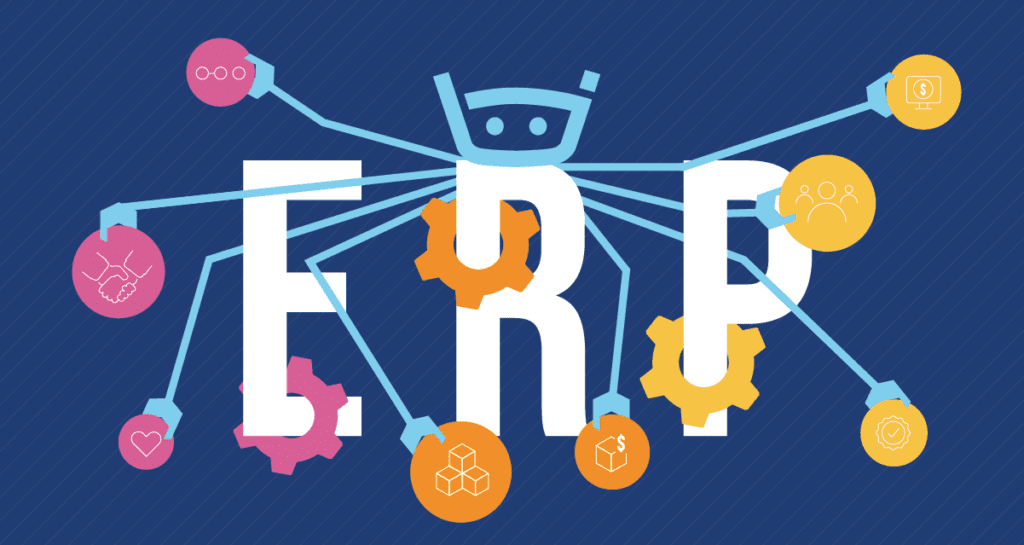
Automation is changing the way we do business.
In 2022, McKinsey & Company released a global survey on digital transformation through automation. The survey found that 70% of businesses reported they are “at least piloting automation technologies in one or more business units or functions.” Two-thirds reported they had experienced positive outcomes from automation, including improved quality control, customer satisfaction, employee engagement, and reduced costs.
I’m the CFO at a Series B-funded manufacturer making sustainably-sourced sportswear and athletic equipment. We’ve got traction in the marketplace, and we’re scaling up our operations. At the same time, we’re adding many new suppliers as we expand our manufacturing capacity and product base. It’s time to look at where we can automate key functions, like finance and accounting, to manage our costs and grow the business.
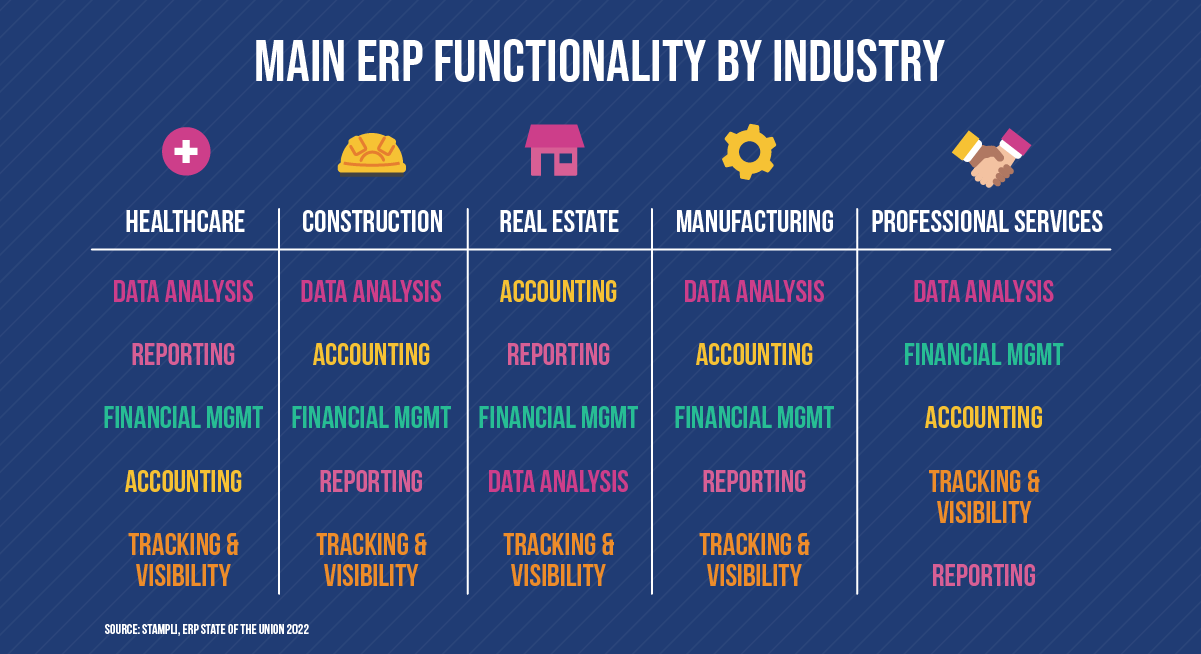
Many of our current processes involve manual and repetitive tasks that are time-consuming, error-prone, and just plain boring. These tasks are great candidates for automation. They let us save money and become more efficient and free our team members to work on stuff that’s more aligned with our mission (and a lot more fun, too).
In this podcast, Ben Murray, founder of The SaaS CFO, welcomes David Lapter, CFO at Dashlane. As a CFO at a startup, David talks about the importance of learning at every opportunity and understanding the most effective way for a company to grow. Because we’re looking at implementing an enterprise resource planning (ERP) solution to automate our business processes, we need to understand how ERP software solutions work and what they can do for our business.
In this article, we talk about what we learned. Let’s start with a definition of what ERP automation is and what are the benefits of automating business processes.
What is ERP automation, and what does it do?
“ERP automation” actually refers to two different things.
First, it means using ERP systems, modules, and integrations to automate business processes. For example, you can automate end-to-end payroll or inventory management processes with an ERP solution.
Second, it means automating the ERP software’s features and functions through tools like Artificial Intelligence (AI), robotic process automation (RPA), and machine learning. For example, you can use RPA technology to automate manual data entry tasks while using an ERP accounting module.
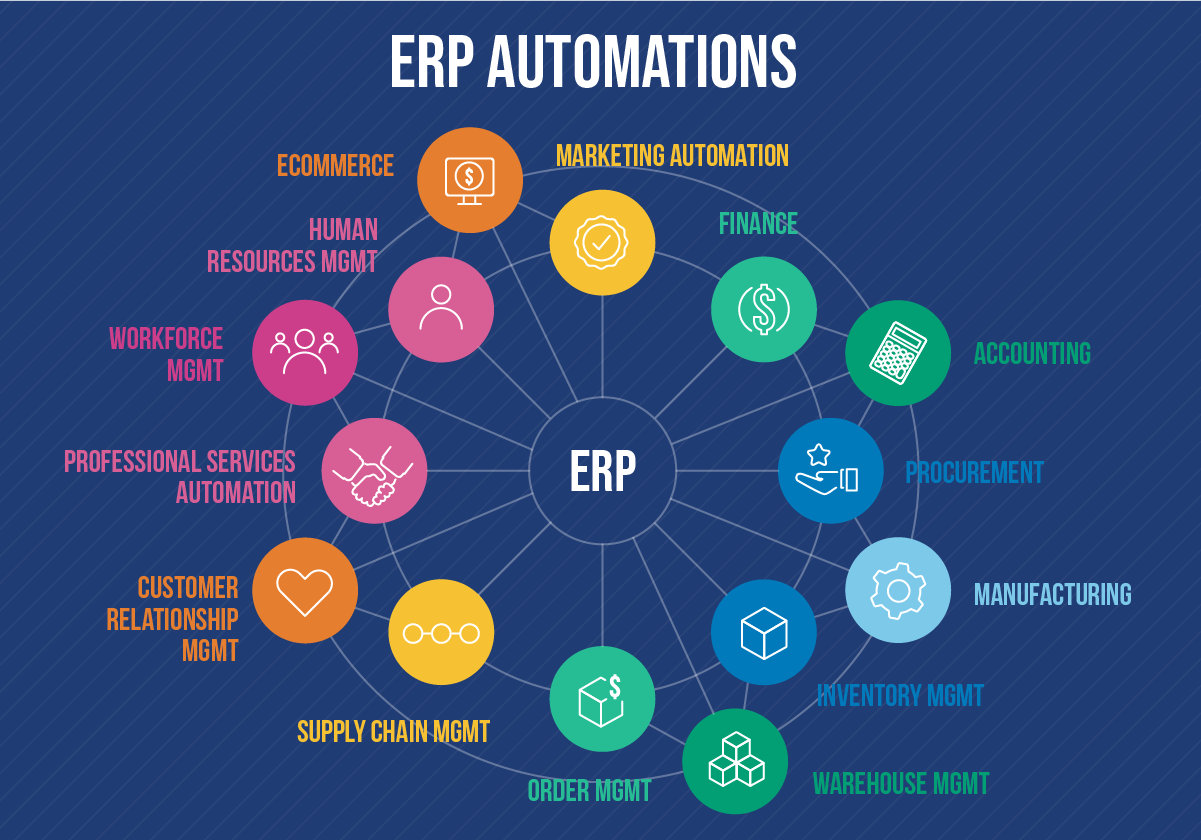
In reality, things aren’t so black and white. ERP automation solutions can include elements of both types of automation, especially when it comes to third-party integrations and data sharing. For example, SAP provides a powerful suite of ERP automation tools that let users develop their own automated workflows and processes. In contrast, Sage Intacct’s Open API takes a different approach by simplifying the process of developing and integrating third-party automation solutions with their ERP.
ERP automation seeks to streamline any manual, repetitive process using automation technologies. This brings a number of big benefits.
Benefits from ERP automation
As a fast-growing manufacturing company in an extremely competitive marketplace, we need to stay on top of our game. And as the CFO, I need to stay on top of our financial data, especially accounts payable. Automating my mission-critical finance and accounting functions lets me access real-time data to manage our cash flow and make informed business decisions. With this in mind, here’s why I’m looking at ERP automation for our business:
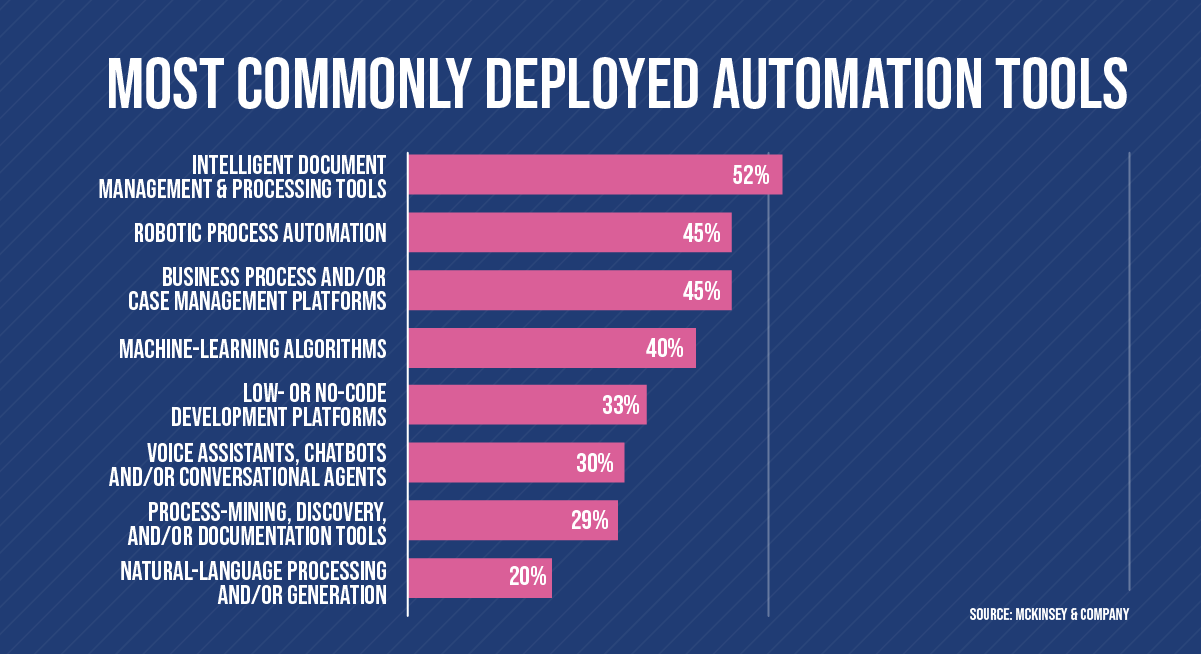
Automation supports sustainability
Sustainability is the cornerstone of our business. ERP automation helps us ensure our products are sustainably produced and sourced in many ways. For example, we can use an automated vendor document management system to ensure our vendors are compliant with sustainability and environmental standards by requiring them to submit certificates and documentation. Or we can use inventory management automation to perform quality checks to ensure products are compliant with sustainability standards and flag us when a product is out of compliance.
Real-time access to data boosts decision-making
With ERP automation, I can access accurate business intelligence and data across every ERP module and third-party integration in real time via a central database. With this level of visibility into every financial transaction, expense, and revenue source, I can act quickly and make informed decisions. I can also keep our CEO (and funders) up-to-date on our financials, saving time and headaches.
Automation enables scalability
ERP automations are scalable, so they will expand when our business grows, and our needs evolve. This also builds agility because it reduces the need to add (and train) new employees as we get bigger.
We can stay compliant with regulations
As a growing business, we’ve got a lot on our plate. We want to focus on growth, so it’s a big benefit to us that automated ERP functions can help us stay compliant with regulations. Automated AP and accounting tools enforce our internal controls and ensure we keep a complete audit trail. Good news for our funders, one less headache for me.

Our employees are more engaged
Our employees work for us because they believe in our mission. While there’s always hard work to be done, we want our employees to feel engaged and valuable. By automating boring routine tasks, ERP automation frees our employees to do enjoyable, more meaningful work.
The benefits make a strong case for implementing ERP automation, mainly because they help us stick to our mission while improving our process efficiency. That keeps our funders happy, and it gives us a nice edge over our competitors.
Next, let’s discuss how ERP automation can help our business.
Use cases for ERP automation systems
We can use ERP automation to optimize almost any of our business processes. Here are a few processes that I’m looking at right now:
Accounts Payable (AP)
Most ERPs include an accounts payable module or submodule in their finance functionality. Different AP modules vary, but most automate core processes like invoice processing, vendor document management, expenses, and supplier payments. AP automation would greatly benefit our business because our supplier base has been expanding as we grow. It would be a big help to manage the increased workloads and get our suppliers paid on time.
Accounts receivable (AR)
Most of our customers are small to medium retailers and outfitters. Automation can help us improve our customer service by streamlining AR processes like order placement and fulfillment, shipping, and order information recording. For example, by moving to an automated online ordering system, we can make it easier for our customers to order from us and pay their invoices.
Account reconciliation
ERP automation simplifies core accounting tasks like account reconciliation. We can detect and mitigate duplicate payments, fraud, or human error by automatically matching our general ledger entries with our bank statements.
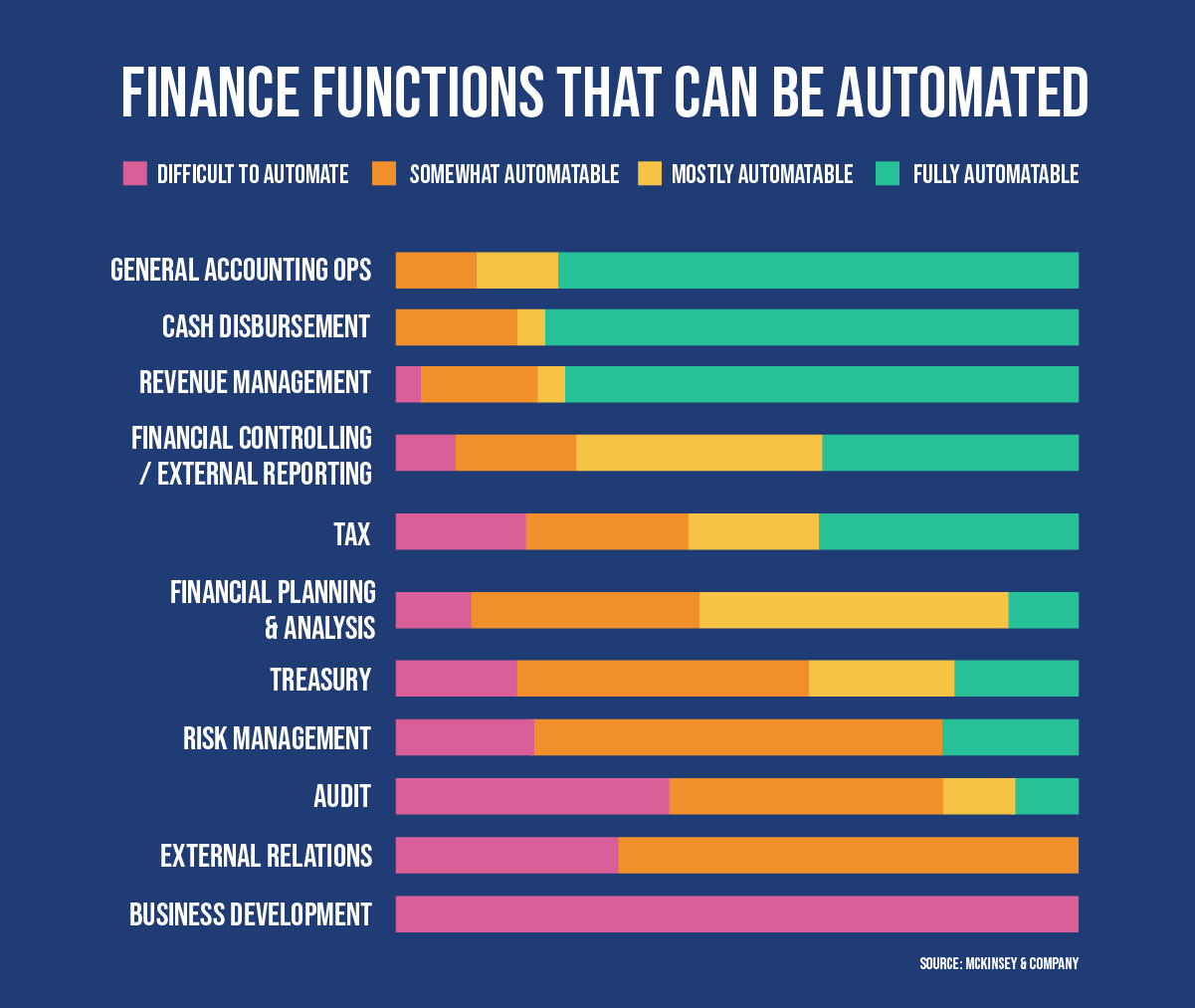
Human resources and payroll
Automation can simplify many of our HR tasks, especially recruitment and payroll. This allows us to have immediate access to employee information, simplify the recruiting and onboarding process, monitor job performance, and accurately track employee work hours.
Supply chain management
Our success relies heavily on the health of our supply chain, so automation is a big help to us. For example, we can automate procurement and logistics processes to simplify jobs like ordering material, shipping, managing inventory, and tracking vendor contracts. Automated supply chain management solutions can also help us centralize and share data so we have total visibility and control over our supply chain operations.
Inventory management
Managing inventory is all about managing, sharing, and forecasting data. An inventory management system can provide us with data-driven insights and reports, such as identifying top-performing SKUs, calculating landed cost of goods sold (COGS), and sales by category and channel.
We can also incorporate Internet of Things (IoT) technology in the warehouse to get real-time visibility into excess inventory, shortages, planned replenishment, and other key metrics.
Next Steps: planning for automation
To kick off our automation initiative, we need to start with a top-down assessment of our mission and existing workflows and needs. This assessment will give us the roadmap to identify which business processes are the best candidates for automation. From there, we can determine which automation tools we want to use.
For us, that means starting with sustainability and employee wellbeing. As part of our assessment of any automation tool, we need to understand the numbers (the ROI of each tool) and the indirect benefits and costs to our business.
For example, automating accounts payable has several direct benefits to our business, like faster invoice processing and reduced costs, but it also has many indirect benefits. AP automation can also reduce fraud and errors, improve relationships with our suppliers, and let our employees work on more rewarding projects.
By taking this holistic approach, we can find automation solutions, and solution providers, that align with our values while helping us succeed. For example, we’re going with Stampli as our accounts payable automation solution provider. Not only can Stampli help us with improving our AP processes, but they are also recognized as a positive and engaged employer.
Automation may be changing how we do business, but choosing the right automation solution helps us succeed by not changing a thing about why we do business.
Stampli – empower SAP with industry-leading AP automation
Stampli brings all your AP-related communication, documentation, and workflows into one place for complete visibility and control. It supports all native functionality for over 70 ERPs, including Sage Intacct, Microsoft, SAP S/4HANA, Oracle Netsuite, QuickBooks, and 70 others. With Stampli, you can implement industry-leading AP Automation in weeks, not months, with no changes to your ERP or how you do things.
Stampli is simple to learn and use. Billy the Bot™ automates nearly all your invoice capture, coding, routing, fraud detection, and other manual tasks. For even greater efficiency, Stampli’s core cloud-based AP solution is complemented by a suite of integrated products that include Stampli Direct Pay, Stampli Card, Stampli Insights, and Stampli Advanced Vendor Management.
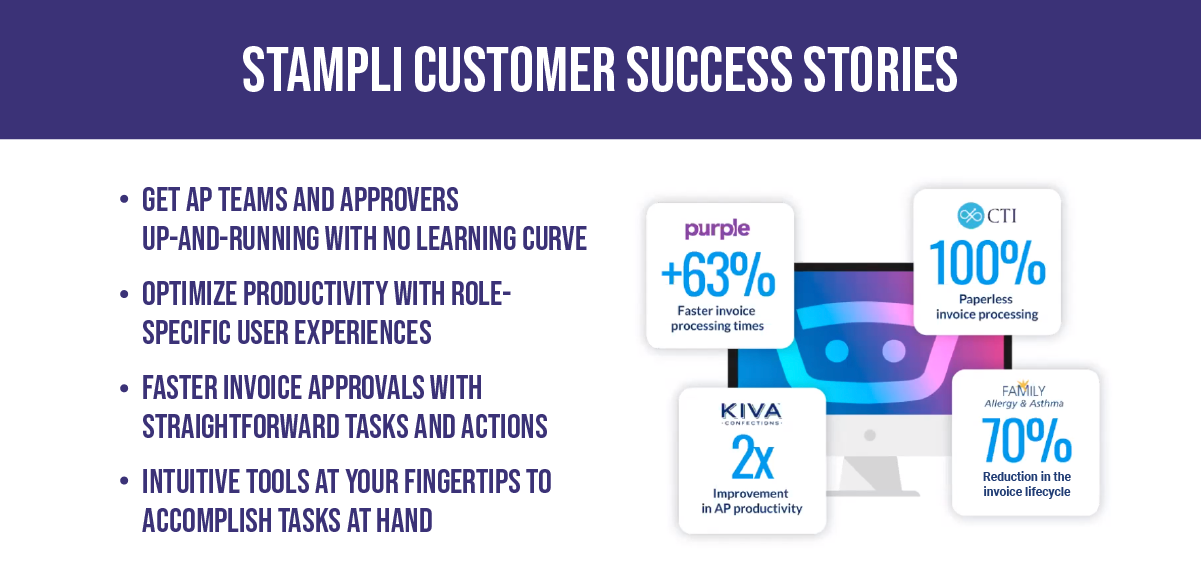
How Stampli makes you successful
Get efficiency, visibility, and control from the only AP automation solution purpose-built for Accounts Payable. Here are some ways that Stampli makes AP Automation easier for customers.
- Invoice processing: Automate invoice capture, coding, approvals, and more to make AP more efficient and accurate.
- Extended business-hours customer support: Our team of AP & ERP experts is available when needed, with less than 60-second response times, to ensure you get the most out of Stampli.
- Billy the Bot™: Advanced AI that adapts to your unique AP processes and business structure to automate manual tasks and eliminate manual work in your SAP ERP.
- Fast onboarding support: Your dedicated Customer Success team member will help you set up Stampli to match how you already do business.
- Vendor management: Manage vendor onboarding, information, and documentation to strengthen relationships and maintain compliance.
- Multi-subsidiary support: Process and pay invoices across companies, offices, departments, or locations in a single place.
- Insights: Gain instant visibility into invoices, employee productivity, and AP processes with powerful dashboards, analytics, and reporting tools.
Take control of your SAP accounts payable processes today. Contact Stampli for a free demo.